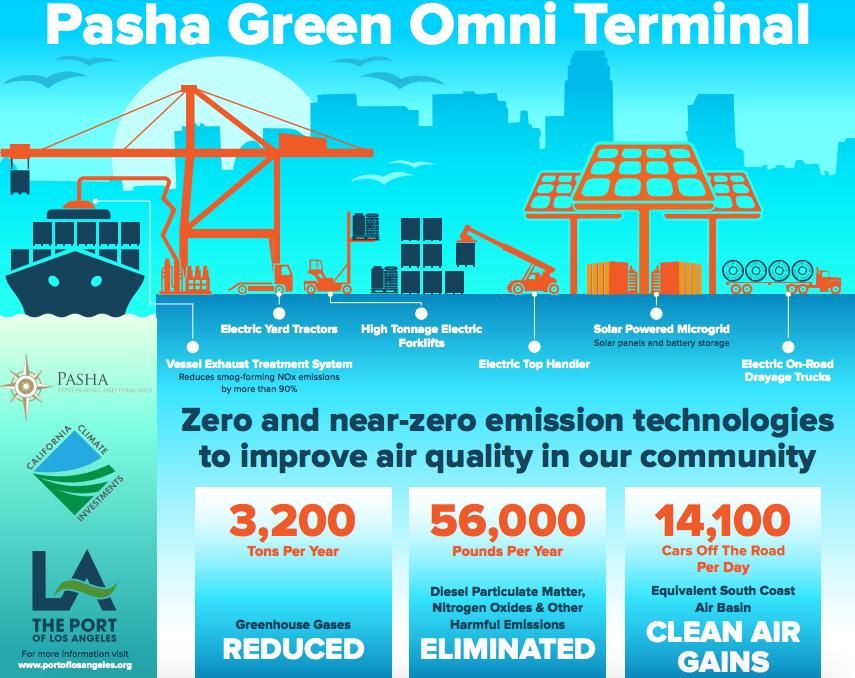
Port of LA to Open World’s First Off-Grid Terminal Powered Entirely by Renewables

The Port of Los Angeles—the nation’s largest port by container volume and cargo value—is building the world’s first marine terminal able to generate all of its energy needs from renewables.
Once development is complete, the 40-acre Pasha Green Omni Terminal will be able to run completely off-grid during power outages thanks to an onsite, 1.03-megawatt solar micro-grid that also features 2.6 megawatt-hour battery storage system and energy management technology to maximize usage, according to a news release.
The terminal will be home to an entire fleet of new or retrofitted zero-emission cargo handling equipment, such as electrified yard tractors, high-tonnage forklifts, drayage trucks, a top handler and wharf cranes. The project will also demonstrate ShoreCat, the next generation of the Marine Exhaust Treatment System for capturing at-berth vessel emissions without plugging into shore power. The port is the first to pilot such a system.
The developers estimated that the entire $26.6-million project is expected to slash more than 3,200 tons per year of greenhouse gases and nearly 28 tons annually of diesel particulate matter, nitrogen oxides and other harmful emissions from operations.
This project will further stamp out harmful emissions in the region, as the ports of Los Angeles and Long Beach have already reduced diesel particulate matter emissions by 80 percent in the last decade through various measures, Daily Breeze noted.
Example of new #solar-powered paneling at Pasha Green Omni Terminal. #PortofLA pic.twitter.com/QU4C28bp5x
— Port of Los Angeles (@PortofLA) July 12, 2016
The clean air gains will be the equivalent of taking 14,100 cars a day off the road in the South Coast Air Basin—an especially notable feat as the port of Los Angeles is also California’s single largest stationary source of pollution, as Gizmag noted.
“This is a Wright Brothers moment,” Jeffrey Burgin, senior vice president of Pasha Stevedoring and Terminals L.P, said. “We’re going to be the proving ground to change the paradigm of how large industrial facilities can run on clean energy. We’re confident we can show this is absolutely attainable.”
Pasha, a private cargo handling company, has thrown in $14.5 million into the project from mostly cap-and-trade dollars, the Daily Breeze reported.
As the Daily Breeze explained, one of the biggest issues confronting local and state officials is how to transition the $700 billion freight-dependent shipping industry from carbon-emitting diesel trucks and ships to zero or low-emissions alternatives.
During an announcement at the port last week, Los Angeles mayor Eric Garcetti said that the Pasha Green Omni Terminal is one of a series of clean air initiatives and clean technology deployments aimed at reducing emissions from the Southern California goods movement industry.
Garcetti has set a goal to increase zero emission goods-movement trips to 15 percent by 2025.
“The Port of Los Angeles is leading the world toward a sustainable future, and today we’re raising the bar again,” Garcetti said. “With this partnership, we begin a new era for global shipping where we can eliminate emissions as we power our economy ahead. I look forward to seeing this innovative technology in action.”
While the project boasts many green attributes and is a welcome upgrade to aging infrastructure, another important element of the project is that, during the event of a natural disaster, the completely off-grid port could still supply energy and basic goods to Southern California or could serve as a military base.
“The [Pasha Green Omni] terminal is considered a breakbulk terminal, meaning it can handle things in addition to containers, or steel slabs,” Phillip Sanfield, spokesperson for the Port of Los Angeles, told Gizmag. “It’s one of the reasons it was chosen for this demonstration project because it can bring in emergency supplies and equipment.”
The eco-friendly terminal is also good news for the nearby neighborhood of Wilmington, a community disproportionately impacted by industrial pollution.
“We don’t have to chose between one and the other; we can have healthy communities and a healthy port,” Garcetti said during his announcement last week. “It’s an unacceptable price to pay for a bustling port.”

According Gizmag, port officials expect the green technologies at the terminal to be up and running by the end of 2016.

 233k
233k  41k
41k  Subscribe
Subscribe 